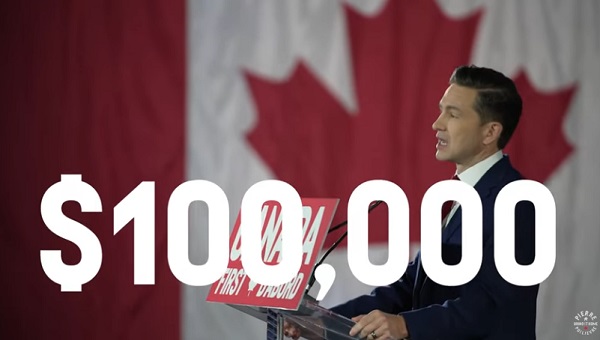Alberta
Alberta going after entrepreneurs and immigrants working as health-care professionals

Improving the Alberta Advantage Immigration Program
Changes to the Alberta Advantage Immigration Program (AAIP) will make it easier for in-demand workers and entrepreneurs to become permanent residents.
Alberta’s economy has momentum, and Alberta’s government is committed to further growth and diversification so the province remains the economic engine of Canada. In 2022, nearly 50,000 people from around the world chose Alberta as the place to invest, work and raise their families.
AAIP is an economic immigration program that enables Alberta to nominate qualified workers in in-demand sectors for permanent residency. By improving the program, Alberta will be more competitive in attracting skilled newcomers from across the world.
“Alberta is a land of opportunity. In our province, you can find the career you want, take home a strong and regular paycheque, and still spend time with family and friends. Not only do people around the world want to come here, we want them to come here to be a part of our communities and our prosperity, and help Alberta continue to grow and succeed.”
Alberta’s government is making five improvements to the AAIP that will help both businesses and international skilled workers.
Changes to the Rural Entrepreneur and Rural Renewal streams will help Alberta’s rural communities remain vibrant and grow. A lowered investment threshold of $100,000 for the Rural Entrepreneur Stream will will open the door to additional qualified entrepreneurs who wish to establish or purchase an existing business in participating rural Alberta communities. Removing the requirement for a letter from a settlement agency under the Rural Renewal Stream will help rural communities attract, recruit and welcome newcomers based on local needs.
“Bringing more workers needed in the province will be key to continuing to grow Alberta’s economy and meeting our labour shortages. These changes to AAIP show our commitment to making Alberta one of the best places in the world to put down roots, contribute positively to your community and be prosperous.”
Alberta has the best front-line health care workers in the world and the province will work to have the right supports in place to ensure Albertans get the care they need when and where they need it. A new, dedicated pathway to attract medical professionals to Alberta means that up to 30 per cent of Alberta’s Express Entry Stream allocation in 2023 will be reserved for health-care professionals with an Alberta job offer from a health-care sector employer and who meet the requirements to work in one of the eligible health occupations.
Two more changes will see a new phone line that directly connects AAIP staff members with clients and collaboration with the federal Economic Mobility Pathways Pilot. Participating in this pilot will help refugees with the skills and qualifications needed in Canada to immigrate through existing economic programs.
“These policy changes are aimed squarely at filling needed skills gaps, boosting vibrancy in rural communities, and creating more economic opportunity for refugees. We applaud these moves to enhance economic immigration in a way that is responsive to specific provincial needs.”
“From HV Global Immigration, we would like to thank Minister Rajan Sawhney for listening and proactively implementing reasonable changes to the AAIP. Apart from the other improvements, change in minimum investment at AAIP’s Rural Entrepreneur Stream would definitely help new and prospective immigrants to qualify for this program. This change will generate more revenue and create jobs for Albertans. Last, but not least, the new information phone line is going to be a big relief. Thanks once again Minister Sawhney for your hard work and listening to our ideas and solutions.”
Quick facts
- Alberta currently has about 100,000 job openings across the province.
- Alberta is forecasting a cumulative job shortage of 33,100 workers by 2025 across several occupations, skill levels and sectors (source: Alberta’s Occupational Outlook, 2021-2030).
- Immigration, Refugees and Citizenship Canada sets AAIP’s annual nomination limits.
- Alberta recently received an increase in nominations:
- 9,750 nominations in 2023
- 10,140 nominations in 2024 (estimated)
- 10,849 nominations in 2025 estimated)
- Alberta recently received an increase in nominations:
Alberta
Alberta takes big step towards shorter wait times and higher quality health care

From the Fraser Institute
On Monday, the Smith government announced that beginning next year it will change the way it funds surgeries in Alberta. This is a big step towards unlocking the ability of Alberta’s health-care system to provide more, better and faster services for the same or possibly fewer dollars.
To understand the significance of this change, you must understand the consequences of the current (and outdated) approach.
Currently, the Alberta government pays a lump sum of money to hospitals each year. Consequently, hospitals perceive patients as a drain on their budgets. From the hospital’s perspective, there’s little financial incentive to serve more patients, operate more efficiently and provide superior quality services.
Consider what would happen if your local grocery store received a giant bag of money each year to feed people. The number of items would quickly decline to whatever was most convenient for the store to provide. (Have a favourite cereal? Too bad.) Store hours would become less convenient for customers, alongside a general decline in overall service. This type of grocery store, like an Alberta hospital, is actually financially better off (that is, it saves money) if you go elsewhere.
The Smith government plans to flip this entire system on its head, to the benefit of patients and taxpayers. Instead of handing out bags of money each year to providers, the new system—known as “activity-based funding”—will pay health-care providers for each patient they treat, based on the patient’s particular condition and important factors that may add complexity or cost to their care.
This turns patients from a drain on budgets into a source of additional revenue. The result, as has been demonstrated in other universal health-care systems worldwide, is more services delivered using existing health-care infrastructure, lower wait times, improved quality of care, improved access to medical technologies, and less waste.
In other words, Albertans will receive far better value from their health-care system, which is currently among the most expensive in the world. And relief can’t come soon enough—for example, last year in Alberta the median wait time for orthopedic surgeries including hip and knee replacements was 66.8 weeks.
The naysayers argue this approach will undermine the province’s universal system and hurt patients. But by allowing a spectrum of providers to compete for the delivery of quality care, Alberta will follow the lead of other more successful universal health-care systems in countries such as Australia, Germany, the Netherlands and Switzerland and create greater accountability for hospitals and other health-care providers. Taxpayers will get a much better picture of what they’re paying for and how much they pay.
Again, Alberta is not exploring an untested policy. Almost every other developed country with universal health care uses some form of “activity-based funding” for hospital and surgical care. And remember, we already spend more on health care than our counterparts in nearly all of these countries yet endure longer wait times and poorer access to services generally, in part because of how we pay for surgical care.
While the devil is always in the details, and while it’s still possible for the Alberta government to get this wrong, Monday’s announcement is a big step in the right direction. A funding model that puts patients first will get Albertans more of the high-quality health care they already pay for in a timelier fashion. And provide to other provinces an example of bold health-care reform.
Alberta
Alberta’s embrace of activity-based funding is great news for patients

 From the Montreal Economic Institute
From the Montreal Economic Institute
Alberta’s move to fund acute care services through activity-based funding follows best practices internationally, points out an MEI researcher following an announcement made by Premier Danielle Smith earlier today.
“For too long, the way hospitals were funded in Alberta incentivized treating fewer patients, contributing to our long wait times,” explains Krystle Wittevrongel, director of research at the MEI. “International experience has shown that, with the proper funding models in place, health systems become more efficient to the benefit of patients.”
Currently, Alberta’s hospitals are financed under a system called “global budgeting.” This involves allocating a pre-set amount of funding to pay for a specific number of services based on previous years’ budgets.
Under the government’s newly proposed funding system, hospitals receive a fixed payment for each treatment delivered.
An Economic Note published by the MEI last year showed that Quebec’s gradual adoption of activity-based funding led to higher productivity and lower costs in the province’s health system.
Notably, the province observed that the per-procedure cost of MRIs fell by four per cent as the number of procedures performed increased by 22 per cent.
In the radiology and oncology sector, it observed productivity increases of 26 per cent while procedure costs decreased by seven per cent.
“Being able to perform more surgeries, at lower costs, and within shorter timelines is exactly what Alberta’s patients need, and Premier Smith understands that,” continued Mrs. Wittevrongel. “Today’s announcement is a good first step, and we look forward to seeing a successful roll-out once appropriate funding levels per procedure are set.”
The governments expects to roll-out this new funding model for select procedures starting in 2026.
* * *
The MEI is an independent public policy think tank with offices in Montreal, Ottawa, and Calgary. Through its publications, media appearances, and advisory services to policymakers, the MEI stimulates public policy debate and reforms based on sound economics and entrepreneurship.
-

 2025 Federal Election1 day ago
2025 Federal Election1 day agoRCMP memo warns of Chinese interference on Canadian university campuses to affect election
-

 2025 Federal Election1 day ago
2025 Federal Election1 day agoResearchers Link China’s Intelligence and Elite Influence Arms to B.C. Government, Liberal Party, and Trudeau-Appointed Senator
-

 Alberta2 days ago
Alberta2 days agoAlberta takes big step towards shorter wait times and higher quality health care
-

 Business2 days ago
Business2 days agoTrump raises China tariffs to 125%, announces 90-day pause for countries who’ve reached out to negotiate
-

 2025 Federal Election1 day ago
2025 Federal Election1 day agoThe status quo in Canadian politics isn’t sustainable for national unity
-

 2025 Federal Election1 day ago
2025 Federal Election1 day agoPoilievre Announces Plan To Cut Taxes By $100,000 Per Home
-

 2025 Federal Election23 hours ago
2025 Federal Election23 hours agoTwo Canadian police unions endorse Pierre Poilievre for PM
-

 Business2 days ago
Business2 days agoScott Bessent Says Trump’s Goal Was Always To Get Trading Partners To Table After Major Pause Announcement






